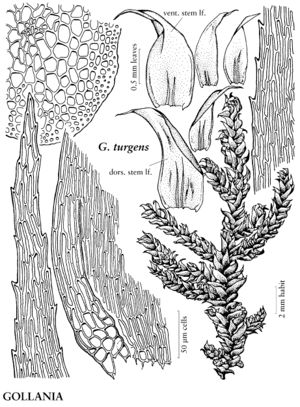Gollania turgens
Bot. Mag. (Tokyo) 79: 769. 1966.
Stems 7 cm, complanate-foliate, secund. Stem-leaves with dorsal leaves strongly falcate, 2.7–2.9 × 0.6–0.8 mm; base subcordate, gradually narrowed; margins markedly recurved at base of apex and below, subentire proximally, irregularly serrulate distally; costa forks parallel, 1/4–1/3 leaf length; alar cells 6–8 in marginal row, 8–10 in transverse row; medial laminal cells weakly flexuose, lumen 60–80 × 2–3 µm, walls porose; ventral leaves flat at apex. Branch leaves 1.6–2 × 0.3–0.5 mm. Inner perichaetial leaves with margins slightly reflexed at apex, serrate, costa double or indistinct, laminal cell-walls thick. Sporophytes unknown.
Habitat: Boreal forest zone to arctic tundra, wet or moist rock, often calcareous
Elevation: moderate to high elevations (700-4800 m)
Distribution

B.C., Yukon, Alaska, Asia (China), Asia (Japan), Asia (Nepal), Asia (Russia)
Discussion
Gollania turgens is known from ten or fewer localities in the flora area. The species exhibits a North Pacific (eastern Asia–western North American) distribution, although the range of the eastern Asian population extends more strongly southward. The range of this species is roughly overlapped by that of Takakia (Takakiaceae). Gollania turgens is much like Hypnum in appearance, especially the densely pinnate branching and falcate leaves, but is distinguished by the long and parallel costae, markedly recurved and serrulate margins of stem leaves, thick-walled and porose laminal cells of stem leaves, and well-differentiated alar cells.
Selected References
None.
